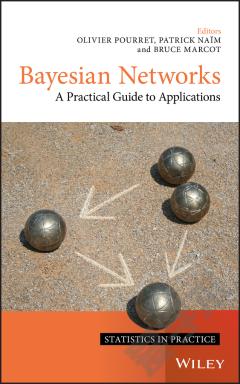Bayesian Networks —— A Practical Guide to Applications
----- 贝叶斯信念网络:应用实用指南
Foreword. Preface. 1 Introduction to Bayesian networks. 1.1 Models. 1.2 Probabilistic vs. deterministic models. 1.3 Unconditional and conditional independence. 1.4 Bayesian networks. 2 Medical diagnosis. 2.1 Bayesian networks in medicine. 2.2 Context and history. 2.3 Model construction. 2.4 Inference. 2.5 Model validation. 2.6 Model use. 2.7 Comparison to other approaches. 2.8 Conclusions and perspectives. 3 Clinical decision support. 3.1 Introduction. 3.2 Models and methodology. 3.3 The Busselton network. 3.4 The PROCAMnetwork. 3.5 The PROCAMBusselton network. 3.6 Evaluation. 3.7 The clinical support tool: TakeHeartII. 3.8 Conclusion. 4 Complex genetic models. 4.1 Introduction. 4.2 Historical perspectives. 4.3 Complex traits. 4.4 Bayesian networks to dissect complex traits. 4.5 Applications. 4.6 Future challenges. 5 Crime risk factors analysis. 5.1 Introduction. 5.2 Analysis of the factors affecting crime risk. 5.3 Expert probabilities elicitation. 5.4 Data preprocessing. 5.5 A Bayesian network model. 5.6 Results. 5.7 Accuracy assessment. 5.8 Conclusions. 6 Spatial dynamics in the coastal region. 6.1 Introduction. 6.2 An indicator-based analysis. 6.3 The Bayesian network model. 6.4 Conclusions. 7 Inference problems in forensic science. 7.1 Introduction. 7.2 Building Bayesian networks for inference. 7.3 Applications of Bayesian networks in forensic science. 7.4 Conclusions. 8 Conservation of marbled murrelets in British Columbia. 8.1 Context/history. 8.2 Model construction. 8.3 Model calibration, validation and use. 8.4 Conclusions/perspectives. 9 Classifiers for modeling of mineral potential. 9.1 Mineral potential mapping. 9.2 Classifiers for mineral potential mapping. 9.3 Bayesian network mapping of base metal deposit. 9.4 Discussion. 9.5 Conclusions. 10 Student modeling. 10.1 Introduction. 10.2 Probabilistic relational models. 10.3 Probabilistic relational student model. 10.4 Case study. 10.5 Experimental evaluation. 10.6 Conclusions and future directions. 11 Sensor validation. 11.1 Introduction. 11.2 The problem of sensor validation. 11.3 Sensor validation algorithm. 11.4 Gas turbines. 11.5 Models learned and experimentation. 11.6 Discussion and conclusion. 12 An information retrieval system. 12.1 Introduction. 12.2 Overview. 12.3 Bayesian networks and information retrieval. 12.4 Theoretical foundations. 12.5 Building the information retrieval system. 12.6 Conclusion. 13 Reliability analysis of systems. 13.1 Introduction. 13.2 Dynamic fault trees. 13.3 Dynamic Bayesian networks. 13.4 A case study: The Hypothetical Sprinkler System. 13.5 Conclusions. 14 Terrorism risk management. 14.1 Introduction. 14.2 The Risk Influence Network. 14.3 Software implementation. 14.4 Site Profiler deployment. 14.5 Conclusion. 15 Credit-rating of companies. 15.1 Introduction. 15.2 Naive Bayesian classifiers. 15.3 Example of actual credit-ratings systems. 15.4 Credit-rating data of Japanese companies. 15.5 Numerical experiments. 15.6 Performance comparison of classifiers. 15.7 Conclusion. 16 Classification of Chilean wines. 16.1 Introduction. 16.2 Experimental setup. 16.3 Feature extraction methods. 16.4 Classification results. 16.5 Conclusions. 17 Pavement and bridge management. 17.1 Introduction. 17.2 Pavement management decisions. 17.3 Bridge management. 17.4 Bridge approach embankment - case study. 17.5 Conclusion. 18 Complex industrial process operation. 18.1 Introduction. 18.2 A methodology for Root Cause Analysis. 18.3 Pulp and paper application. 18.4 The ABB Industrial IT platform. 18.5 Conclusion. 19 Probability of default for large corporates. 19.1 Introduction. 19.2 Model construction. 19.3 BayesCredit. 19.4 Model benchmarking. 19.5 Benefits from technology and software. 19.6 Conclusion. 20 Risk management in robotics. 20.1 Introduction. 20.2 DeepC. 20.3 The ADVOCATE II architecture. 20.4 Model development. 20.5 Model usage and examples. 20.6 Benefits from using probabilistic graphical models. 20.7 Conclusion. 21 Enhancing Human Cognition. 21.1 Introduction. 21.2 Human foreknowledge in everyday settings. 21.3 Machine foreknowledge. 21.4 Current application and future research needs. 21.5 Conclusion. 22 Conclusion. 22.1 An artificial intelligence perspective. 22.2 A rational approach of knowledge. 22.3 Future challenges. Bibliography. Index.
{{comment.content}}








 京公网安备 11010802027623号
京公网安备 11010802027623号